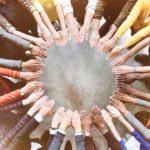The bancarization of Africa: repeating the success of M-Pesa in Kenya
Africa continues to be a challenge for many companies seeking to do business in countries with very particular conditions, and where the most successful policy is often not to think in terms of what isn't there, but to take maximum advantage of the resources that are available. A few years ago M-Pesa triumphed with its model, which now needs to be replicated to achieve the same success in other nations on the continent.

Massive access to banking and financial services, savings and loans through solid financial institutions is one of the features of developed societies and a hallmark of social inclusion. This is why it is particularly worth highlighting cases like that of M-Pesa in Kenya, as an exportable formula for successfully bancarizing the rest of Africa.
Seeking success with available resources
The low rate of bancarisation in Africa seriously restricts its potential for growth. With rates that have historically been below 20% it is very difficult to encourage long-term savings or social provision, and makes them absolutely dependent on foreign borrowing. This is a problem that can be seen in other parts of the globe, but which is particularly acute in a continent that has such an urgent need for growth.
A look at the real situation in Africa –the physical limitations, scant resources, cultural restrictions, and drawbacks of all kinds that we might be encountered–, is enough to deter many from the almost impossible task of massively bancarising lower-income Africans (the vast majority).
Fortunately this was not the view taken by Vodafone, who in around 2003 launched their M-Pesa app (mobile money in Swahili) through their Kenyan subsidiary Safari. So what is M-Pesa and why is it so successful? In a word, it is based on exploiting what is available rather than bemoaning everything that isn't.

In fact, when they looked at the low rate of bancarisation described above, they realized that exactly the opposite was happening in the case of cell phones. In the developed world, these devices have become massively widespread among all social strata and can be handled by a wide range of people regardless of their place on the educational spectrum. These were going to serve as the branch offices for M-Pesa.
They designed a very light app which was capable of working in practically any telephone –however basic–, and after a series of tests they opted to make the cell phone a kind of electronic wallet –a way of making collections and payments. What does M-Pesa offer its users? The basic package is the following:/p>
• Customers can deposit money in their M-Pesa account and then have it available through ATMs and particularly via the network of agencies it has distributed all around the country in small shops and businesses (the other great beneficiaries of M-Pesa in its double facet).
• They can transfer money to other M-Pesa users or to third parties.
• They can pay invoices or top up their cellphone.
M-Pesa is not a bank; it is what in Europe would be known as an Electronic Money Institution –a payment processor. M-Pesa cannot capture deposits as such; it cannot create money through the fractional reserve. However it undoubtedly contributes to bancarising society by including people who were previously excluded within the financial circuit and familiarizing them with its working, thereby creating new formulas for relating to the world of finances, with negligible costs and operating as financial agents for other banks in the strictest sense of the term.
Initiatives like M-Pesa largely account for the fact that in Kenya over 40% the population has a bank account, and more than 60% use mobile technology to make collections or payments. They have been given what they needed with the tools they already had and used every day.
Kenya and M-Pesa have become the landmark for bancarization processes for the rest of Africa. In fact it has already made the leap to Tanzania, Lesotho, Mozambique and Egypt, and –in what may be a watershed– has gained a toehold in Asia via its launch in India and in Europe with its bridgehead in Romania.